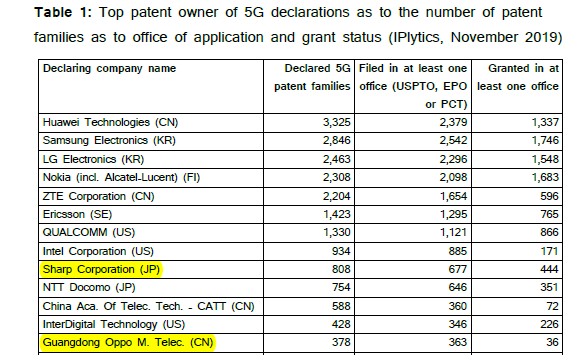Just two months after the UK Supreme Court’s decision (as reported here) which held that a UK court has the jurisdiction to set global SEP rates, the Shenzhen Intermediate Court made the first decision ever (Guangdong Oppo Mobile Telecommunications Corporation, Ltd v Sharp Corporation) to confirm a Chinese court’s jurisdiction to determine global FRAND rates for SEPs.
Background
Guangdong Oppo Mobile Telecommunications Corp., Ltd (Oppo) is a Chinese company specialising in electronic and mobile communication products such as smartphones, audio devices and power banks. Sharp Corporation (Sharp) is a Japanese corporation that designs and manufactures electronic products. In the latest 5G patent report released by IPLytics, both Sharp and OPPO ranked as top patent owners of 5G patents (as one indicator of leadership in the telecoms industry) and Oppo was described as a company ‘newly entered into the market’.

Back in October 2018, Sharp sent Oppo a list that included a large number of SEP patents that Sharp was willing to license to Oppo. Oppo and Sharp then started licensing negotiations in February 2019. During the negotiations, Sharp filed patent infringement lawsuits against Oppo in both Japan and Germany for infringing its 4G/LTE patents.
The case
In March 2020, Oppo filed the first instance case against Sharp at the Shenzhen Intermediate Court for:
- Sharp’s breach of FRAND terms during the licensing negotiation, including ‘coercing Oppo into negotiation using infringement injunctions, overpricing and unreasonably delaying the negotiation’;
- global SEP rates of Sharp’s 3G, 4G and Wi-Fi SEP portfolio; and
- a compensation of 3 million RMB (350,000 GBP) for the breach of FRAND terms from Sharp.
The decision
Sharp raised an objection to the Shenzhen Intermediate Court’s jurisdiction over this SEP licensing dispute, arguing that the case should be dealt by a Japan Court, and that the global SEP rates for Sharp’s 3G, 4G and Wi-Fi SEP portfolio is beyond the jurisdiction of the Shenzhen Intermediate Court. The Shenzhen Intermediate Court made a decision in respect of Sharp’s jurisdiction objection in October 2020, as follows:
Whether a Chinese court has jurisdiction over the case
In light of the fact that an SEP licensing dispute is neither a typical contract dispute nor a typical infringement dispute, the Shenzhen Intermediate Court considered a few factors to determine the jurisdiction, such as whether the implementation of the patent or the performance of the contract, is within the territory of China – i.e. whether the SEP licensing dispute is properly connected with China. If one of such actions is within the territory of China, the case shall be deemed to have a proper connection with China and the Chinese court shall have jurisdiction over the case.
In the present case, the plaintiff Oppo is a Chinese company and its production, research and development take place in China. The defendant Sharp is the patentee of the Chinese patents and has property interests in China. Therefore, the court held that the case is properly connected with China and the Chinese court thus has jurisdiction over the case.
Whether the Chinese SEP rates should be separated from the global SEP rates
The court first pointed out that evidently, the previous licensing negotiation between the two parties concerned the global SEP rates of Sharp’s 3G, 4G and Wi-Fi SEP portfolio.
Secondly, the court held that global SEP rates will improve the overall efficiency by solving the dispute between the two parties fundamentally and avoiding multiple litigations in different countries – and therefore such global SEP rates are in line with the intent of FRAND terms and should not be separated from the Chinese SEP rates.
Conclusion
This might be one of the first cases worldwide that involves setting global rates for Wi-Fi SEPs. The consideration of global SEP rates has thus expanded from cellular networks such as 3G and 4G to WLAN.
Perhaps more importantly, this decision holds that a Chinese court is competent to hear issues relating to the setting of global FRAND rates for SEP patents, much like the UK Supreme Court recently held that it was competent to decide on the setting of global FRAND rates for SEP patents. However, this first instance decision was ruled by an intermediate court in China. Therefore, the decision may be appealed, and it will be interesting to see whether this decision will be upheld by the Chinese Supreme People’s Court.

